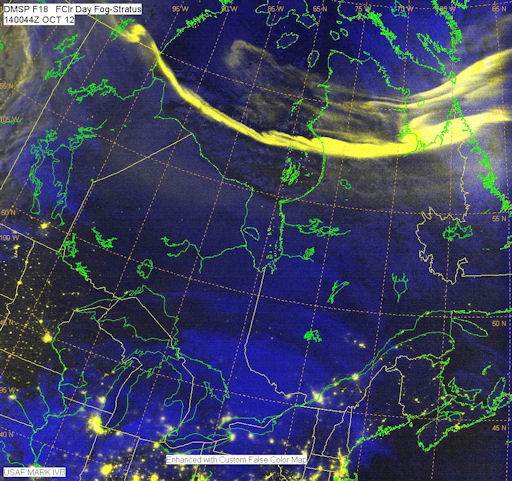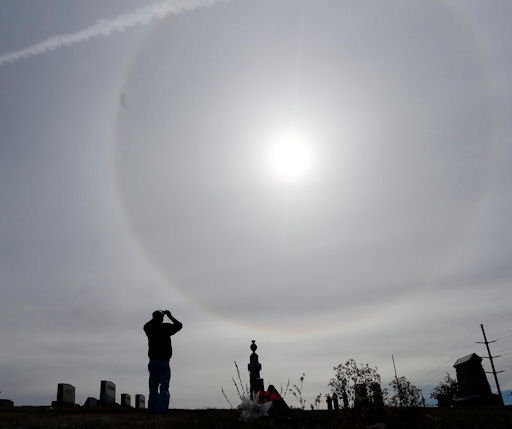ORIONID METEOR SHOWER: Next weekend, Earth will pass through a stream of debris from Halley's Comet, source of the annual Orionid meteor shower. Forecasters expect ~25 meteors per hour when the shower peaks on Oct. 21st. [video] [full story] [NASA Chat]
AURORAS FROM ORBIT: Orbiting high above Earth, low-light cameras onboard the US military's fleet of DMSP satellites have captured some magnificant auroras lately. On Oct. 12th, a band of lights cutting across the Hudson Bay in Canada were nearly as bright as the city lights on the continent below:
"This image came from DMSP's F18 satellite," says Paul McCrone who processed the data at the US Navy's Fleet Numerical Meteorology and Oceanography Center in Monterey, CA. "It shows auroras, some wispy clouds, and the brightly-lit urban areas of the northeastern United States."
One can only imagine what sky watchers would have seen if this bright band had descended over the populated regions of the United States. We won't find out this week. NOAA forecasters say the chances of a geomagnetic storm at mid-latitudes during the next three days is no more than 1%. Aurora alerts: text, voice.
SUN HALOS: As the northern hemisphere heads deeper into autumn, and ultimately winter, icy clouds become more commonplace. In other words, 'tis the season for sun halos. Charles Yeager photographed this specimen over Cleveland, Minnesota on Oct. 15th:
"This halo looked extremely large over the farm land of southern Minnesota," says Yeager.
In fact, it was 22 degrees in radius. That's how much hexagonal ice crystals in cirrus clouds bend the light of the sun overhead. Related crystals can also create sun pillars, sundogs, and a variety of other luminous halos. Look around the sun; you never know what you might see.

![]()
Solar wind
speed: 400.4 km/sec
density: 0.4 protons/cm3
explanation | more data
Updated: Today at 1505 UT
![]()
X-ray Solar Flares
6-hr max: C2 1434 UT Oct17
24-hr: C7 0802 UT Oct17
explanation | more data
Updated: Today at: 1459 UT
![]()
![]()
![]()
Daily Sun: 17 Oct 12
![]()
![]()
Sunspot 1589 is decaying and no longer poses a threat for M-class solar flares. Credit: SDO/HMI
![]()
![]()
![]()
Sunspot number: 107
What is the sunspot number?
Updated 17 Oct 2012
Spotless Days
Current Stretch: 0 days
2012 total: 0 days (0%)
2011 total: 2 days (<1%)
2010 total: 51 days (14%)
2009 total: 260 days (71%)
Since 2004: 821 days
Typical Solar Min: 486 days
Update 17 Oct 2012
The Radio Sun
10.7 cm flux: 137 sfu
explanation | more data
Updated 17 Oct 2012
![]()
![]()
![]()
Current Auroral Oval:
![]()
Switch to: Europe, USA, New Zealand, Antarctica
Credit: NOAA/POES
![]()
![]()
![]()
Planetary K-index
Now: Kp= 2 quiet
24-hr max: Kp= 2 quiet
explanation | more data
![]()
Interplanetary Mag. Field
Btotal: 7.0 nT
Bz: 1.4 nT north
explanation | more data
Updated: Today at 1507 UT
![]()
![]()
![]()
Coronal Holes: 16 Oct 12
![]()
![]()
There are no large coronal holes on the Earthside of the sun. Credit: SDO/AIA.






